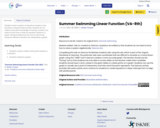
Relations and Functions: Domain and Range Mathematics Instructional Plan
- Subject:
- Mathematics
- Material Type:
- Lesson Plan
- Provider:
- VDOE
- Author:
- VDOE
- Date Added:
- 10/07/2024

Relations and Functions: Domain and Range Mathematics Instructional Plan

Explore how parameters of the function equation affect its graph; Assess understanding of transformations - Rich Mathematical Task Template and Student Version

The cell is vitally important to all living things. Students will choose ONE of the following projects to reinforce their study of cell structure and function. Be sure to look at the rubric on page 2 for grading criteria.

This is a Desmos activity to explore domain and range of continuous functions. Students do not need prior knowledge of domain and range; this is an exploratory instructional activity.

This is an exploratory activity. Students should have some prior knowledge of evaluating functions for given domain inputs using function notation.This lesson will walk students through using a table and plotting points. By the end of the lesson students should walk away understanding that a line is infinitely many points.

Analyze various situations of collecting and interpreting data to determine functionality. Practice determining if a relation is a function and creating functions using a VDOE MIP following the exploration.

Developed by the Science Museum of Western Virginia, this educator outline is intended to assist in guiding middle school-aged students through various activities using the Rokit Smart robot kit. The Rokit Smart utilizes Arduino, a widely-used open-source environment for programming that enables users to create interactive electronic objects. Designed through modules, the activities can be grouped to fit after-school, summer camp, or other student enrichment needs.

Developed by the Science Museum of Western Virginia, this educator outline is intended to assist in guiding middle school-aged students through various activities using the Rokit Smart robot kit. The Rokit Smart utilizes Arduino, a widely-used open-source environment for programming that enables users to create interactive electronic objects. Designed through modules, the activities can be grouped to fit after-school, summer camp, or other student enrichment needs.

Developed by the Science Museum of Western Virginia, this educator outline is intended to assist in guiding middle school-aged students through various activities using the Rokit Smart robot kit. The Rokit Smart utilizes Arduino, a widely-used open-source environment for programming that enables users to create interactive electronic objects. Designed through modules, the activities can be grouped to fit after-school, summer camp, or other student enrichment needs.

Developed by the Science Museum of Western Virginia, this educator outline is intended to assist in guiding middle school-aged students through various activities using the Rokit Smart robot kit. The Rokit Smart utilizes Arduino, a widely-used open-source environment for programming that enables users to create interactive electronic objects. Designed through modules, the activities can be grouped to fit after-school, summer camp, or other student enrichment needs. *Module 4 is meant to be done after Modules 1-3 are completed.

Khan Academy is a free website. Teachers can create classes and assign practice problems to students. This resource has listed 8th grade math VA standards that align to the functions and slope-intercept topics.

Khan Academy is a free website. Teachers can create classes and assign practice problems to students. This resource has listed 8th grade math VA standards that align to the functions and slope-intercept topics.

Students solve a system of equations based on two situations. Using the Desmos task, students do not need to have prior knowledge of solving a system, but need to know how to write an equation based on a graph. Students determine the cost of swimming using two different situations by interpreting a graph.

In this self-checking activity, students will match 18 cards, identifying the slope, y-intercept, and slope-intercept form of each equation to match each of the six tables.